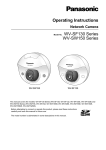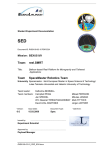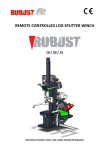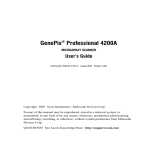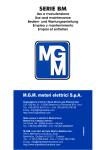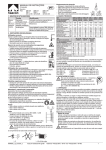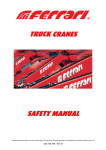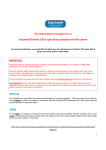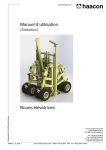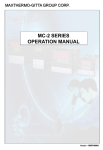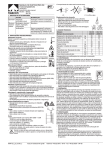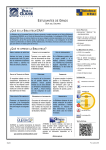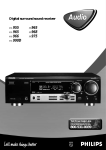Download ESG Electric Winch - Lift Turn Move Ltd
Transcript
Betriebsanleitung (Original) Operating Manual (Translation) Manuel d‘utilisation (Traduction) Manual de instrucciones (Traducción) Istruzioni per l‘uso (Traduzione) Manual de instruções de funcionamento (Tradução) Elektrische Seilwinde Typ ESF / ESG Electrical rope winch type Treuil à câble électrique type Torno de cable eléctrico tipo Argano a fune elettrico tipo haacon hilft heben Guincho de cabo eléctrico tipo 094278_a_de_gb_fr_es_it_pt_eseilwi_s haacon hebetechnik gmbh Josef-Haamann-Str. 6 D-97896 Freudenberg/Main Tel: +49 (0) 93 75/84-0 Fax: +49 (0) 93 75/84-66 e-mail: [email protected] Internet: www.haacon.com haacon hebetechnik gmbh – Telefon +49 (0) 9375 - 84-0 – Fax +49 (0) 9375 - 84-66 DE GB FR ES IT PT 1. GENERAL INFORMATION Contents 1. GENERAL INFORMATION.................................................14 1.1 Operating Instruction Specifications.............................14 1.2 Machine Type, Series, Year of Construction ................14 1.3 Manufacturer, Service Address.....................................14 1.4 Intended Use..................................................................14 GB 2. SAFETY INSTRUCTIONS...................................................15 2.1 General Safety Instructions...........................................15 2.2 Safety Instructions Operator.........................................15 2.3 Safety Instructions User................................................16 2.4 Safe Storage, Transport, and Assembly.......................16 2.5 Save Service / Maintenance, Troubleshooting.............16 2.6 Safety Instructions Electrical Equipment......................17 2.7 Noise Protection............................................................17 3. Product Description..........................................................17 3.1 Design Type ESF............................................................17 3.2 Design Type ESG...........................................................17 3.3 Technical Data................................................................18 4. Installation..........................................................................19 4.1 Mounting........................................................................19 4.2 Installation Position, Gear Venting. ...............................19 4.3 Ropes.............................................................................19 4.3.1 General Notes.............................................................19 4.3.2 Rope Attachment to the Drum ...................................19 4.3.3 Rope Course...............................................................19 4.3.4 Rope End Connections ..............................................20 4.4 Load Hooks ...................................................................20 5. Commissioning..................................................................20 5.1 Power Supply ................................................................20 5.2 Minimum requirements..................................................20 5.3 Options...........................................................................20 1.1 Operating Instruction Specifications The contents are the basis for safe, appropriate, and economical operation. The operating instructions contain important notes on design, commissioning, handling, operation, and maintenance. The operating instructions must be available at the device. Persons, who are assigned to work with/at the device device, e.g.: – Operation, care – Troubleshooting – Maintenance and servicing – Transport must be familiar with the contents and act accordingly. Symbols used in the operating instructions: Danger for life and health of persons, device, and material Danger by suspended loads for life and health of persons Danger by electric current for life and health of persons Danger by drawing in of extremities Passenger transport prohibited Notes and tips on use 1.2 Machine Type, Series, Year of Construction The type plate for identification of the rope winch: 6. Operation............................................................................21 7. Examination, Service, Maintenance..............................21 7.1 Inspection intervals........................................................21 7.2 Examination before Commissioning and after substantial Changes before Recommissioning...........................21 7.3 Recurring Examination..................................................21 7.4 Determination of the Service Life Consumption...........22 7.5 Examination Rope..........................................................22 7.6 Examination Load Hook.................................................22 7.7 Bremsmotor...................................................................22 7.8 Gear................................................................................22 8. Options................................................................................22 8.1 Limit switch.....................................................................22 8.2 Pressure Roll..................................................................23 8.3 Slack Rope Switch.........................................................23 8.4 Emergency Hand Operation..........................................23 8.5 Drum Release................................................................23 8.6 Control with Pendant Pushbutton, direct......................24 8.8 Control, indirect, with Electrical Load Limiter ..............24 9. Troubleshooting. ...............................................................25 10. Decommissioning............................................................25 ................................................... 74 11. Anhang A / Appendix A / Annexe A / Anexo A / Appendice A/ Anexo A........................................................................79 Konformitätserklärung / Declaration of Conformity / Déclaration de Conformité / Declaracion de conformidad / Dichiarazione di conformitá / Declaracão de Conformidade..............................................................82 Type designation - Article number Customer number (KVG)/Position Series Number 1.3 Manufacturer, Service Address haacon hebetechnik gmbh Josef-Haamann-Straße 6 D 97896 Freudenberg/Main Tel.: +49 (0) 9375-84 0 Fax: +49 (0) 9675-84 66 e-mail: [email protected] Internet: www.haacon.com 1.4 Intended Use Only used as intended for safe operation. The operator is responsible for damage to persons and property, which result from non-intended use. The manufacturer's liability and warranty becomes void in the case of arbitrary changes. – Only suitable for raising, lowering, and pulling freely movable loads. – Only use lifting winches for raising and lowering loads vertically or on inclined surfaces. – Only usepulling winches for moving loads on horizontal surfaces. – Only use in a sound technical condition. – Only instructed personnel may install, operates, and maintenance and the device. – Dimension the connection construction sufficiently. – Attach the winch distortion-free. – Detachable drums are only permissible for vehicle salvage winches, winches for boat trailers and pulling winches. All documents are protected by copyright law. All industrial property rights reserved. 094278_a_de_gb_fr_es_it_pt_eseilwi_s haacon hebetechnik gmbh – Telefon +49 (0) 9375 - 84-0 – Fax +49 (0) 9375 - 84-66 14 – The following is not permitted: – Exceeding the permissible load (see type, load plate and technical data). – Conveyance of passengers – Persons standing under suspended loads. – Pulling away jammed or blocked loads, dragging of loads and pulling diagonally. – Transporting burning liquid material. – Working with defective winches, rope or load carrying equipment. – Working outside of the permissible temperature range. – Operation in tropical environment. Safety devices Check the safety devices regularly for perfect function (--> also Chapter 7 and 8): Operating range: – The winch corresponds to the EN 14492-1 "Power driven winches" as well as the Accident Prevention Regulations BGV D8 "Winches, hoists, and pulling equipment". The equipment is not certified for – Building elevators (BGV D7). – Stages and studios (BGV C1). – Conveying loads above lines and pipes, through which combustible gases or liquids which could also be harmful to health only with control units according to safety category 2. – Lifting equipment for persons (ZH 1/461). – Use in explosive environment (ATEX). 1 2 Holding brake Limit switch 3 4 Pressure roll Slack rope switch 5 Load limiting device, overload protection Motor shut-down during Emergency Hand Operation The device is unsuitable for – – – – – – Continuous operation (see technical data, motor group). Excessive inching operation. Use during constant vibration. Use on seagoing vessels and mobile offshore equipment. Aggressive environment. Forestry. GB 6 Limited suitability for (specific design): Always check before beginning work Required according to EN 14492-1; Adjust before commissioning; Regular examination Regular examination Adjust before commissioning; Regular examination Required according to EN 14492-1 for loads ≥ 1000 kg; Adjust before commissioning; Regular examination Adjust before commissioning; Examination before use and according to inspection plan – Stationary offshore equipment 2. SAFETY INSTRUCTIONS 2.1 General Safety Instructions The device corresponds to all relevant regulations. Nevertheless its use can endanger the user or third parties and/or damage the device and other material assets in the case of: – Not instructed (trained) personnel. – Non-intended use. – Inappropriate service/maintenance. Certain residual risks are given even if all safety instructions have been observed. Whoever works with or in the vicinity of the device, must be familiar with these dangers and obey instructions, which prevent that residual risks result in accidents or damages. The residual risks are marked by symbols (explanation in Chapter 1.1). 094278_a_de_gb_fr_es_it_pt_eseilwi_s 7 Motor shut-down with Adjust before commissioning; Regular detached drum examination Regular examination 8 „Emergency stop“ switch No. 2, 3, 4, 5 ,6 ,7 ,8 optional 2.2 Safety Instructions Operator The operator is obligated to plan and monitor all necessary measures to guarantee safe operation. The operator must ensure: – The use is as intended (Chapter 1.4). – The safety of the device is analysed according to its application and environmental conditions and that recognizable risks (e.g. danger of injury at rope inlet and rotating drum) are assessed and eliminated. – Before commissioning, the device has been examined and approved according to the appropriate international and national regulations. – Operation is only carried out in a perfect, functional condition – The safety devices are regularly examined for their effectiveness, only ropes are used, which correspond to a valid standard and are suitable for the application case. (Chapter 4.3) – The required, personal protection equipment for the assembly, operation, maintenance and repair personnel is available and used. – The operating manual must always be available at the device's operational location in a legible and complete condition. – Only qualified and authorised personnel may operate, maintain, examined, and repair the device.The personnel has been regularly instructed on all appropriate issues con- haacon hebetechnik gmbh – Telefon +49 (0) 9375 - 84-0 – Fax +49 (0) 9375 - 84-66 15 – – – – – cerning industrial safety and environmental protection, and is familiar with the operating instructions and in particular with the therein contained safety instructions. The permissible load is clearly recognizable for the user. Signs have not been removed from the device and remain legible. No substantial changes have been carried out on the device. Required tests have been carried out and documented. The used spare and wearing parts correspond to the technical requirements specified by the manufacturer. This is guaranteed for original spare parts. 2.3 Safety Instructions User Never: – – – – – – – Loop the rope around the load. Pull the lifting rope over stationery parts or edges. Exceed the permissible load-carrying capacity. Manipulate safety devices. Pull or drag loads diagonally. Wrench jammed loads away. Unreel rope to rope attachment. Two coils must always remain on the drum. – Work with untensioned rope operate without safeguard against jumping off the drum. – Work without lifting limiter. All persons, who operate the device independently must be Avoid to ensure operational reliability: accident protection regulations and have been assigned by the operator. – Continuous operation, as well as continuous inching operation, exceeding of the duty cycle of the motors, as well as remaining service life according to drive group and load. GB suitable for this purpose, familiar with the valid safety and Only use the device when it is in a technically perfect condition and as intended (Chapter 1.4), with regard to safety and dangers, while considering the operating instructions. Please check: Check before lifting the load: Is the load suspended safely in the load hook and is it completely accommodated in the hook? Is the safety flap closed? For attaching the load, the respective national regulations for load carrying devices apply (in Germany the BGR 500, Chapter 2.8). Are the necessary safety devices (Chapter 2.1) present and functional? Has the brake function always been checked before beginning work? Is personal protection equipment worn, as required by local regulations? Has the load carrying equipment and rope been checked every time before beginning work and has the complete device being checked to a visual inspection? Store clean, dry and protected. Take measures against corrosion on wire rope, hook and brake. Do not work negligently! Stop defective device immediately and inform superior. First repair defects, then continue working. Replace damaged load carrying equipment and ropes. Repairs are not allowed. – Only use original spare parts. – Do not modify or alter the device. Attachments may neither impair safety nor function. Are there any transport damages ? (Immediately notify the supplier). Is personal protection equipment worn? (Safety glass, safety shoes, if necessary helmet). Are suitable, standardised and examined hoisting gear and load securing devices used ? Dimensions and weights --> technical data (Chapter 3.3). – The following is prohibited: Transport of passengers Persons standing under lifted loads. Note: Warn persons in the immediate vicinity. We refer to the applicable German accident prevention regulations and, for use outside GERMANY, to the respective national regulations! Touching the drum and rope intake during operation. Work on live components. 2.4 Safe Storage, Transport, and Assembly Transport and assembly by authorised persons, familiar with the valid safety and accident prevention regulations as well as with the operating instructions. Please check: Always: – Only fasten load securing device to base plate, gear, drum and/or drum shaft. – Transport device protected against impacts and shocks, falling over or toppling. – Assemble on stable, flat surface. – Attach the device such a way, that neither the load nor other effects can change the position the position. 2.5 Save Service / Maintenance, Troubleshooting Always observe the intervals specified or indicated in the operating instructions for recurring tests/inspections. All persons, who work on the device must be suitable for this purpose, familiar with the valid safety and accident protection regulations and have been assigned by the operator. Before starting special and maintenance measures: Have persons in the danger zone been informed and warned? Areas shut off? Is the device load-free and sufficiently cooled down? Has the main switch been switched off and the device safeguarded against unexpected restarting? (Actuate emergency stop, close main switch and attach warning signs) Manual interventions in an operating device can lead to severe accidents. If switching on is nevertheless necessary (e.g. rope replacement), then this may only be carried out while observing special safety precautions. – Is suitable protection equipment worn and have appropriate protective measures been met, if required? (e.g. falling protection when working at large heights) 094278_a_de_gb_fr_es_it_pt_eseilwi_s haacon hebetechnik gmbh – Telefon +49 (0) 9375 - 84-0 – Fax +49 (0) 9375 - 84-66 16 – Have possibly released screw connections being tightened safely again? – If necessary safety devices have been disassembled, have they been reassembled, examined, and documented immediately after concluding work? – Are operating and auxiliary materials disposed safely and in an environmental-friendly manner? optional: h/i e 2.6 Safety Instructions Electrical Equipment Disconnect from the power supply when working on the electrical equipment. Only permit authorised specialists to work on the electrical equipment. And electrical specialist is a person with suitable training and experience, as well as knowledge of the relevant regulations, who is able to recognize risks and avoid dangers, caused by electricity. Always keep control cabinets closed. Never: g f j e f g h i j Grooved drum Limit switch Mounting plate with pressure roll Slack rope switch Control unit (direct, indirect) with pendant pushbuttons Control unit with pendant pushbuttons and electrical load limiter Emergency Hand Operation Work on live parts. During inspection, maintenance, and repair work: Disconnect device from power supply, safeguard against restarting First check that electrical components are disconnected from the power supply, then ground and short-circuit them, and finally insulate live neighbouring components. Always work with a second person, who when working on live components (exceptional case) can actuate the emergency stop button or main switch in case of an emergency. Use only voltage-insulated tools. – Always replace fuses by fuses of the same type with the specified amperage. – Never bypass fuses! – Do not carry out any constructional and safety reducing modifications to the control units. – Guarantee perfect grounding of the electrical system by a protective conductor system. 3.2 Design Type ESG B C A A B C Gear with mounting holes Brake motor (400 V and/or 230 V) Drum, smooth Base plate with outer bearing optional: 2.7 Noise Protection Noise does not represent a significant danger with this device. Values --> technical data (Chapter 3.3). Hearing protection can nevertheless be necessary according to the local conditions. i/j e h f 3. Product Description Standard arrangement of drum rotation direction and rope discharge (see also Chapter 4.3.3). Can deviate in the case of customised versions. 90° 90° 180° 180° 270° g k 0° 0° 270° Clockwise (rh) Anticlockwise (lh) This direction cannot be changed for winches with 230 V AC - control. The rotation direction of the drum can be changed on all other winches by modifying phasing on the power supply. 3.1 Design Type ESF B A B C e f g h i j k Grooved drum Limit switch Pressure roll Slack rope switch Control unit (direct, indirect) with pendant pushbuttons Control unit with pendant pushbuttons and electrical load limiter Emergency Hand Operation Possible as special design: l m Gear with mounting holes Brake motor (400 V and/or 230 V) Drum, smooth C A 094278_a_de_gb_fr_es_it_pt_eseilwi_s l Divided drum m Detachable drum haacon hebetechnik gmbh – Telefon +49 (0) 9375 - 84-0 – Fax +49 (0) 9375 - 84-66 17 GB 2 9,6 9,1 5 7,9 1,25 11,5 8,6 6 Rope speed [m/min] Rope tractive force [kN] Rope capacity [m] Rope speed [m/min] 1Am 1Am 4 3 20,9 6 2 8,3 4 1 1Am 8,3 4 1 11 26 1.3 6 8,6 11,5 1,65 7,8 7,3 1,8 7,1 3,4 2 ABC 200 7,5 1,1 21,5 18 150 Weight [kg] wo. rope, without options Type 500 38 200 23 ≤ 75 400 43,5 ≤ 83 7 7,9 2x10 2x0,67 7,1 2x5 2x0,75 ABC 6 8,6 2x16 re 1Am 8,3 4 1 2m 8,3 4 1 11 2x38 150 29 1,07 0.37 1Am 8,3 4 1 1Am 8,3 4 1 11 79 0,95 2x0,48 6 8,6 34 1,25 2x0,62 7,9 22 1,35 7,1 10 1,5 ABC 150 10,3 4 3 1 Bm 250 32,5 1,43 0,55 re 1 Bm 1 Bm 13 5 1 8,7 4 2 11 79 1,6 6 8,6 34 2,05 7,8 22 2,25 7 10 ABC 2,5 1Am 13 5 1 11 53 1,6 5 9,1 28 2 8,2 18 2,2 7,2 8 AB 250 1Am 8,3 4 1 2M 8,3 4 1 11 1Am 1,1 re 13 5 1 2M 13 5 1 11 2x45 2x1,6 6 9 2x20 2x2 8,2 2x12 2x2,2 7,4 2x6 2x2,5 haacon hebetechnik gmbh – Telefon +49 (0) 9375 - 84-0 – Fax +49 (0) 9375 - 84-66 ABC 31,5 7 3 IP 54 1 Bm 25,5 7 1 1Am 25,5 7 1 8,8 2x66 2x2,2 7 6,3 2x23 2x3 5,7 2x14,5 2x3,3 5,1 2x7 2x3,75 ABC 1Cm 37,2 8 2 1 Bm 34,8 8 2 7,9 126 5,4 7 5,6 43 7,75 5 27 8,7 4,4 12 AB 14 7 2 7,4 138 5,7 7 5,3 48 8 4,9 30 8,8 4,3 3,8 1,5 re 1Dm 31,5 7 3 1Dm 31,4 9,9 ABC 990 750 90 1 Bm 25,5 7 1 1Am 25,5 7 1 7,4 2x66 2x2,8 7 5,3 2x23 2x4 4,9 2x14,5 2x4,4 4,3 2x7 2x4,95 ABC re 1Am 8,3 ≤ 75 4,5 200 34 4 1 2M 8,3 4 1 11 2x38 2x0,65 6 8,6 2x16 2x0,82 7,8 2x10 2x0,9 7,1 2x5 2x1 ABC 0,55 1 Bm 8,3 4 1 1Am 8,3 4 1 11 79 1,3 6 8,6 34 1,65 7,8 22 1,8 7,1 10 2 ABC 200 Divided drum 230 2M 400 58 ≤ 83 7 7,5 1,1 re 13 5 1 2M 13 5 1 11 2x45 2x1,3 6 9 2x20 2x1,65 8,2 2x12 2x1,8 7,4 2x6 2x2 ABC 400 1 Bm 18,7 6 1 1Am 18,7 6 1 11 82 2,65 5 9,4 35 3,2 8,5 22 3,55 7,5 10,5 4 ABC 8) Use A = Lifting winch, pulling on inclined surfaces B = Boat, vehicle salvage winches C = Pulling winche (Pulling on horizontal surfaces) 990 98 ≤ 72 S3-40 % at 120 c/h or S2-12 min 3,8 1,5 re 1 Bm 1 Bm 37,2 8 2 1 Bm 1 Bm 26,6 7 2 8,8 125 5.4 7 6,3 44 6 5,7 27,5 6,7 5,1 12,5 7,5 33,4 8 1 9 126 4,3 7 6,5 43 5,9 5,8 27 6,6 5,1 12 AB 750 Electrical Rope Winch Type ESG The rope traction force results from masses connected to the rope winch (e.g. rope, hook, load securing devices, lifting racks, magnets, pay load) and applies to installation heights under 1000 m related to sea level. The 1st rope layer, is the rope layer directly located on the drum. 500 52,5 2,82 1 Bm 20,9 6 2 400 ABC 500 1 Bm 18,7 6 1 11 82 3,3 5 9,4 35 4 8,5 22 4,4 7,5 10,5 5 ABC ≤ 70 2x38 2x0,8 6 8,6 2x16 2x1 15,7 2x10 2x1,12 7 2x5 2x1,25 ABC Rope capacity for smooth drums. The rope capacity is reduced when using grooved drums. 1) Nominal strength of the individual wires min. 1570 N/mm2. 2) Nominal strength of the individual wires min. 1770 N/mm2. 3) Nominal strength of the individual wires min. 1960 N/mm2. 4) Standard coil number: 3, the coiling behaviour decreases with increasing coil number. 5) Drive group according to DIN 15020 or FEM 9.511. 6) Other rope diameters on request. 7) Only when lowering with full load. When lifting noise level ≤ 70 dB(A). From 80 dB(A) on, hearing protection must be provided. 250 ≤ 70 Noise level [dB(A)] re 1 Bm IP 54 4,5 0,55 re S3-40 % at 120 c/h or S2-12 min 2,82 1,1 re Duty cycle 1,43 re Protection system 0,55 0.37 1,07 Rated current [A] re 18,7 6 1 1Am 18,7 6 1 11 25 2,65 5 9,4 11 3.2 8,5 7 3,55 7,5 3,2 4 ABC 400 230 1 Bm 1 Bm 1 Bm 1 Bm 10,3 Motor performance [kW] 1Am Drive group 5 13 18,7 6 1 11 25 3,3 5 9,4 11 4 8,5 7 4.4 7,5 3,2 5 ABC 500 1 Bm 1 Bm re 8,3 Min. tensile strength [kN] 5 1 8,7 Drum rotating direction series 4 1 Low-twist rope [mm] Drive group 13 8,3 5 2 4 Min. tensile strength [kN] 1 5 4 Non-twist-free rope [mm] 26 11 11 Rope speed [m/min] 1,6 6 8,6 11,5 2,05 7,8 11 17,8 26 Rope capacity [m] 1 1,6 0,95 8,2 7,3 2,25 7 3,4 ABC 2,5 Rope tractive force [kN] Maximum coil number 6 7,3 Rope capacity [m] 4 2,2 1,35 Rope tractive force [kN] 7,2 7,1 2,8 3,4 Rope capacity [m] Rope speed [m/min] AB 1,5 ABC Use 8 250 Rope tractive force [kN] 150 Nominal load [kg] 400 Electrical Rope Winch Type ESF Voltage [V] 3.3 Technical Data 1st rope layer 2. rope layer 3. rope layer upper layer 094278_a_de_gb_fr_es_it_pt_eseilwi_s Rope diameter 6 GB 18 1 Am 7,5 1,1 li 25,5 71 1Am 650 100 ≤ 83 7 1 Bm 25,5 7 2 25,5 71 7,4 2x66 2x1,9 7 5,3 2x23 2x2,6 4,9 2x14,5 2x2,9 4,3 2x7 2x3,25 ABC 650 1Bm 25,5 7 1 7,4 138 3,8 7 5,3 48 5,2 4,9 30 5,8 4,3 14 6,5 ABC 4. Installation 4.3 Ropes The safety instructions (Chapter 2) apply, in particular for storage, transport and assembly (Chapter 2.4). 4.3.1 General Notes 4.1 Mounting – Connection construction: sufficient strength and rigidity, in order to safely accommodate occurring forces. – Contact surface even, for tension-free attachment. – Use screws, which do not loosen themselves. Screwing specifications: TYPE Dim. Strength Tightening torque [Nm] Number ESF 150 / 200 / 250 M8 8.8 25 ≥4 ESF 400 / 500 ESG 150 / 200 / 250 ESG 400 / 500 ESG 700 / 750 / 990 M10 M8 M10 M12 8.8 8.8 8.8 8.8 50 25 50 87 ≥4 ≥4 ≥4 ≥5 4.2 Installation Position, Gear Venting Replace a plug screw by the provided vent screw depending on the installation position after mounting the rope winch. Turn the connection cover on the gear in such a way that the vent point upwards for winches type ESF as well as for the types ESG 150/200/250/400 and 500. Rope winches of load class over 600 kg are also supplied without oil filling, if specifically required. Installation position B3 applies, if no installation position has been specified. If the operator changes in the assembly position, check the oil level and if necessary adapt before operation. The installation position of the winch is determined by the position of the gear. Therefore, the position of the vent, oil inspection, as well as oil filling amount varies (- - > Appendix A and user operating instructions of the manufacturer). The correct installation position is a precondition for safe operation and must be observed. Installation position B6 and B7 (drum shaft vertical) are inadmissible, since safe winding of the rope is not ensured. Allocation gear to winch --> Spare parts lists. Application temperature: – permissible temperature range: –20°C to +40°C. – First warm up the winch without/with reduced load at temperatures below –10°C. – When using outdoors, protect winch against weather influences. A brake motor with protection system IP 55 is favourable. Provide motor with protective canopy when installed in a vertical position. – In particularly damp environment and with strong temperature fluctuations, the motor can be equipped additionally with a heating element as condensed water protection. – Select a rope suitable for your purposes. The EN 12385-3 e.g. provides selection aids. Wire ropes differ by: – their design/construction. (twist-free, low-twist and nontwist-free rope). haacon recommends rope types 6x19M or 7x19 (not twist-free) and the type 17x7 (low-twist) according to EN 12385. – the strength of the it individual strands. The minimum tensile strength of the rope results from this (–> technical data / type plate). – The rope diameter (–> technical data / type plate). – The impact direction. haacon recommends the use of right- GB handed ropes (Designation Z). Their use is obligatory with grooved drums. – The surface. Only use galvanized or high-grade steel wire rope outdoors. Instructions for use: – One-stranded operation and non-guided loads: Low-twist or twist-free ropes. – Multi-layer coiling: Rope with steel core. – Rope ends: safeguard against unsplicing. – Lubrication extends the service life. Not permissible: – Using rope made of other material than steel, as well as plastic casing – Corrosion, damage, or strong contamination 4.3.2 Rope Attachment to the Drum Lead rope out through the opening of the flanged wheel. Position under the rope clamp slightly projecting and tighten. Attach rope in such a way that it winds up unhampered onto the rotating drum. Kinking or leading across edges is prohibited. If the drum is marked with an arrow, then this indicates the drum rotation direction which must be observed when winding up the rope. 4.3.3 Rope Course Arrange cable drives in such a way that ropes cannot be damaged by contacting each other or by touching immobile and moving constructions. The rope must be wound up evenly and tautly. The rope length is correct, if: > 2 > 1,5 x rope-Ø Condensation (moisture, temperature fluctuations) can result after longer downtimes in corrosion of the mechanical brake, thereby causing brake malfunctions. Corrosion protection can also not prevent this completely. The best is to use the winch regularly. A weekly test run and repeated switching on of the motor, can prevent jamming of the brake according to our experience. 094278_a_de_gb_fr_es_it_pt_eseilwi_s haacon hebetechnik gmbh – Telefon +49 (0) 9375 - 84-0 – Fax +49 (0) 9375 - 84-66 19 5. Commissioning The rope coiling direction is correct, if: A) Right-handed rope = left-handed drum = standard = Required with grooved drum B) Left-handed rope = right-handed drum = exception I Rotation direction of the drum: right II Rotation direction of the drum: left Observe safety notes in Chapter 2. Have an expert check the devices before commissioning (Qualified person, Chapter 7). Carry out the examination according to the supplied test book and following the specifications of the operating instructions (chapter 7) and document the results in the test book. 5.1 Power Supply A GB B A left and a right-handed rope should be preferentially used on a divided drum. The rope direction is correct, if: The deflection pulleys are arranged centrically to the drum at a minimum distance. Largest rope deflection angle for smooth drums < 4°, for grooved drums < 2°. 5.2 Minimum requirements β = Rope deflection angle at the roller β-α or β+α = Rope deflection angle at the drum α = Angle of the drum grooves Measurement (centre drum to centre roller) for standard rope winches. TYPE ESF 150 / 200 / 250 ESF 400 / 500 ESG 150 / 200 / 250 ESG 400 / 500 ESG 700 / 750 / 990 Rule of thumb Minimum distance [m] Drum, smooth Drum, grooved 0,45 0,95 0,5 1,0 1,35 2,9 1,6 3,4 2,1 4,5 7,5 x drum width 16 x drum width 4.3.4 Rope End Connections Permissible according to EN 14492-1: – Asymmetrical rope locks, which correspond to EN 13411-6. – Symmetrical rope locks, corresponding to EN 13411-7 with rope diameter < 8 mm. – Metal and synthetic resin socketing, which correspond to EN 13411-4. – Ferruling and grouting according to EN 13411-3. 4.4 Load Hooks Load hooks are permissible according to DIN 15400 or UNI 9465. Unintentional loosening of the load must be prevented. Hooks with a safety catch fulfil these requirements. 094278_a_de_gb_fr_es_it_pt_eseilwi_s Observe safety notes in Chapter 2.6. Connecting electrical rope winches by means of power plugs is not permissible according to DIN EN 60204-32. – Connection of the power supply to the designated parts L1/ L2/L3/N/PE in the terminal and/or switchbox. --> Connection and/or circuit diagram. In addition: Introduce cables via cable connections, connect protective conductor correctly. Provide the strands with end sleeves. Safeguard supply with 1 and/or 3-pole line safety switch with the characteristic B or C. The rated current of the contactors may not exceed the value of 10 A, in order to prevent fusing of the contactors in case of a short-circuit. – Use contactor, supply cable with main switch, emergency stop with lock. The main switch must be freely accessible for maintenance staff. – Power supply according to the Standards DIN IEC 60038 and DIN EN 50160. Voltage difference at the supply terminals of the rope winch max. ± 5 %. Observe power supply specifications in the circuit diagram. Interrupt the brake coil supply during lifting operation and when pulling loads on inclined services on the direct current side (= faster response of the brake). This is already available in the case of factory installation of the control unit. Procedure -->User manual of the motor manufacturer --> Chapter electrical connections. Allocation gear to winch --> Spare parts lists.Motor rotation direction --> Chapter 3.2. Rope winches must correspond to the requirements of the valid international and national standards and guidelines. It is required in particular that: – Winches are equipped with lifting and lowering limiters (Limit switches). – Rope intake positions in the work area of the operating personnel and in the traffic area are safeguarded. – Winches are equipped with overload protection, if jamming or trapping of the load cannot to be prevented and recognized and forces thereby occur, which overload the winch. An overload protection is required starting from a load-carrying capacity of 1000 kg or a towing force of 10 kN. – Winches are provided with an emergency stop function. – Control equipment for initiating and stopping the movement are equipped with an automatic reset. – Control equipment for lifting (reeling the rope) and lowering (unreeling the rope) is available and reciprocally locked. – Slack rope formation does not cause in the endangering conditions. – The load carrying capacity is clearly recognizable for the user. 5.3 Options haacon mounts the limit switches for options. All switches are connected, wired and checked, if the control unit has been assembled in the factory. Fine adjustments must be carried out on-site according to the operating conditions (Chapter 8). In all other cases, the operator is responsible for wiring the options correctly. haacon hebetechnik gmbh – Telefon +49 (0) 9375 - 84-0 – Fax +49 (0) 9375 - 84-66 20 6. Operation The safety instructions specified in Chapter 2 apply. – Always work with the consideration of safety and risks. – Never overload the winches – When changing the rotation direction of the motor wait until it has come to a standstill. – Observe duty cycle (type plate, technical data in Chapter 3.3). For example 40% ED (according to VDE 0530) means, that the motor can operate for 4 minutes during a period of 10 minutes. It is thereby irrelevant how heavy the load is and whether the 4 minutes are consecutive or in intervals. S2-12 min. means that the motor can run continuously for 12 minutes, afterwards however must cool down to the ambient temperature. – The load must be safely suspended in the load carrying equipment and both must be safely hooked into the load hook and be located on the base of the hook. The safety catch of the hook must be closed. – Always initiate load movement with lowest speed. First tension the rope, it may not be slack at the beginning of the load movement. – Continuously observe load during the movement. – Pay attention to rope damages. Immediately report defects to the responsible person. First repair defects, then continue working. – Carry out required examinations and observe maintenance intervals. Control elements: Lifting / reeling the rope Lowering / unreeling the rope Lifting / reeling the rope (slow / fast) Lowering / unreeling the rope (slow / fast) Pressing initiates the movement, releasing stops it. Function and operation of the options see Chapter 8 7. Examination, Service, Maintenance Winches, lifting and towing appliances including their supporting structure must be examined by an expert: – Before commissioning. – After substantial modifications before recommissioning – At least once annually. – If unusual events have taken place, which could have a damaging effect on the safety of the winch (extraordinary examination, e.g. after longer disuse, accidents, natural occurences). – After repairs, which could affect the safety of the winch. A person is an expert, who due to his professional training and experience has sufficient knowledge in the area of winches, lifting and towing appliances and is familiar with the relevant national industrial safety and accident prevention regulations as well as with the general rules of technology (laws, standards, technical rules and regulations) in such a way, that he can assess the safe operating condition of the device. The examinations must be arranged by the operator. Test results and met measures must be documented in the provided test book. – All monitoring, maintenance and service work serves safe operation and must therefore be carried out carefully and conscientiously. – As far as possible carry out the tests without load. 7.1 Inspection intervals The specified monitoring and maintenance intervals apply within the assumed motor group for normal use and single shift operation. The intervals must be reduced in the case of heavy duty operations (e.g. frequent operation under full load) or special environmental conditions (e.g. heat, dust). 7.2 Examination before Commissioning and after substantial Changes before Recommissioning The examination comprises the correct installation and operational readiness and consists essentially of visual examinations and functional tests. They should guarantee that the device is in a safe condition and that if necessary defects and damages, which are e.g. caused by inappropriate transport, are identified and repaired. The scope of the examination is described in the enclosed test book. The examination after substantial changes depends on kind and extent of the substantial change and must be carried out following the examination before commissioning. 7.3 Recurring Examination The examinations are essentially visual examinations and functional tests, whereby the condition of components regarding damage, wear, corrosion, or other changes is assessed; the completeness and effectiveness of the safety devices must also be determined. The function and brake tests must be accomplished with a load, which nearly achieves the permissible load-carrying capacity. The overload protection must be examined with a test load according to Chapter 8.7. The scope of the examination is described in the enclosed test book. Examination at commissioning (Chapter 7.2) Examination be- Examination / Examination / Maintefore beginning Maintenance every 3 nance every 12 months (Chapter 7.3) work months X X X X X X Screw connections X Brake function Brake – Air gap 2 Switch 1 End position, slack rope, coupling, emergency X hand, control elements, cable, switchbox X Overload protection X Lubricate and clean rope X X Rope and end mountings3 X X Load hook und load carrying equipment 4 Gear – oil level 5 1 If available, --> Chapter 8, 2 --> Chapter 7.7, 3 --> Chapter 7.5, 4 --> Chapter 7.6, 5 --> Chapter 7.8 094278_a_de_gb_fr_es_it_pt_eseilwi_s X X X X X X haacon hebetechnik gmbh – Telefon +49 (0) 9375 - 84-0 – Fax +49 (0) 9375 - 84-66 21 GB 7.4 Determination of the Service Life Consumption The theoretical service life ("D") of the haacon rope winches is according to motor group: Motor group D [h] 1Dm M1 100 1Cm M2 200 1 Bm 1Am M3 M4 400 800 2M M5 1000 After expiry of D, the winch must be taken out of service and forwarded to the manufacturer for a general overhaul. The operator must determine the consumption of this service life annually and document this on the appropriate forms in the test book. Calculation basis --> European Standard FEM 9.755 7.5 Examination Rope GB The rope examination is essentially a visual examination. The rope must be examined before each shift for outer damages, deformations, incipient cracks, and corrosion. The rope must be examined by an expert at least once annually. Notes on appropriate accomplishment can be inferred from the DIN 15020 Sheet 2 "Principles Relating to Rope Drives; Supervision during Operation", as well as EN 12385 1-4 Steel wire ropes - Safety. The following must be examined among others according to these criteria: – Type, number, and position of wire breaks – Temporal sequence of wire break formation – Decrease of the rope diameter – Corrosion – Abrasion – Deformations – Effect of heat – Resting time – Rope attachment Observe safety instructions Chapter 2.5 and 2.6. Only carry out maintenance when disconnected from the mains supply. Execution -->User manual of the motor manufacturer, Chapter Maintenance or Service. Gear allocation to the winch series --> Spare parts lists. 8. Options Some of the available equipment variations (options) are legally required. 8.1 Limit switch Consisting of limit switch and mounting set. The limit switch counts the rotations of the drum. It contains two switching elements for limiting the upper and lower end position. An end stop is required according to DIN EN 14492-1. Selects the end stop in such a way, that: > 2 > 1,5 x rope-Ø – Hooks, load carrying equipment, and load may not knock against the rope winch or its supporting structure. The accuracy of the end stop decreases with increasing length of the reeled rope. Adjusting: Remove protective cover Drive to the "lower" end position (rope unreeled). Adjust a tappet with adjusting screw until the switch responds. Immediately report defects to the responsible person. First repair defects, then continue working. Immediately replace rope, if a strand has broken (use original spare part). 7.6 Examination Load Hook The examination of the load hook is essentially a visual examination. Before each shift, check the hook for outer damage, incipient cracks, wear, expansion, corrosion, and functionality of the safety catch of the hook. Immediately report defects to the responsible person. First repair defects, then continue working. Only use original spare parts. 7.7 Brake motor – Keep cooling air paths clean. – Always examine the function of motor and brake before beginning work. – Check gaskets and power input in certain time intervals. (Compare to power input on the type plate). – Examine the air gap of the brake at least once annually and reset if necessary. Observe safety instructions Chapter 2.5 and 2.6. Only carry out maintenance when disconnected from the mains supply. Execution -->User manual of the motor manufacturer, Chapter Maintenance or Service. Motor allocation to the individual winch series --> Spare parts lists. Adjusting screws Reel rope briefly, stop, unreel again and check "lower" end position. Reel rope and drive to "upper" end position. Adjust the other tappet with adjusting screw until the switch responds. Unreel rope briefly, stop, reel again and check "upper" end position. Drive to the "lower" and "upper" end position again and correct until end positions are reached satisfactorily. Assemble protective cover again. The limit switch is correctly connected and approximately preset, if the control unit is supplied by the factory. Otherwise it is the responsibility of the operator to correctly connect the two switching elements to the control unit. The limit switch is a safety component. – Examine regularly, however at least once annually, as well as before commissioning. 7.8 Gear Load-carrying capacity < 600 kg oil filling, life-long lubrication. Load-carrying capacity > 600 kg oil filling, check oil level annually. Check gaskets of the outlet shafts annually. An oil change is theoretical not required during the service life. 094278_a_de_gb_fr_es_it_pt_eseilwi_s haacon hebetechnik gmbh – Telefon +49 (0) 9375 - 84-0 – Fax +49 (0) 9375 - 84-66 22 8.2 Pressure Roll 8.4 Emergency Hand Operation Applies rope coils to the drum. Designed for up to three rope layers. Before commissioning, adjust the position of the pressure roll to the requirements (number of rope layers).(--> oblong holes) 8.3 Slack Rope Switch Interrupts the drive, as soon as the rope loses its tension, e.g. if the load jams when "lowering" or reaches the ground. Prevents the rope coils jumping off the drum. Prevents during renewed lifting cross layering of the rope. (rope damage). Not available for divided drums! The slack rope switch is made of a spring mounted roll arm . If the rope loses its tension, then the limit switch is triggered by a cam segment. The motor stops. With known rope outlet, the slack rope switch has been adjusted in the factory. Adjust the switch before commissioning according to the local conditions and check its function. For this purpose, loosen screws and rotate the arm appropriately. Then tighten screws again. The slack rope switch has already been connected according to the circuit diagram, if the control unit has been supplied by the factory. Otherwise it is the responsibility of the operator to correctly connect the switching element to the control unit. The slack rope switch is a safety component. – Examine regularly, however at least once annually, as well as before commissioning. The motor brake starts automatically, if the power supply is interrupted. The load movement is stopped immediately. Lower load: Screw in brake lever, vent brake. Lift load: Attach crank to motor, turn anti-clockwise , vent brake. Emergency hand operation only when disconnected from power supply. Exceptional situation! Therefore special attention is necessary. -->Safety instructions in Chapter 2. Only assign instructed personnel. Do not stay under suspended loads or in the danger area. Secure danger zone. LOWERING - NOTE! The load starts moving independently after venting the brake. The load is braked again by releasing the brake lever. Do not exceed suitable lowering speed. Only lower load step by step! If necessary, use the provided crank for lowering. LIFTING – NOTE! Danger of injury by the attached crank, if this is not sufficiently secured before venting the brake. First hold crank, then vent brake! First release the brake lever, then the crank carefully! Inserting the crank interrupts the power supply of the motor. The appropriate switch has already been connected according to the circuit diagram, if a factory control unit is installed. Otherwise it is the responsibility of the operator to correctly connect the switching element to the control unit. The switch is a safety component. – Examine regularly, however at least once annually, as well as before commissioning. The operator must ensure, that the brake is not inadvertently vented during normal operation. e.g. the lever can be unscrewed with 400 V drive units and screwed in into the crank mounting. 8.5 Drum Release Drum release only without load! Only for boat, vehicle salvage, and towing winches; not permissible for lifting winches! m The drum can be separated from drive unit and brake to remove the unloaded rope. Move coupling lever (m) toward the drum. The coupling is positive locking against independent release. If necessary, turn the drum manually and release coupling. The rope is not braked when taking off manually. Slack rope can develop, causing the rope coil to jump of the drum. A pressure roll (Chapter 8.2) can prevent this. The coupling is equipped with a switch, which interrupts the power supply of the motor. This switch has already been connected according to the circuit diagram, if a factory control unit is installed. Otherwise it is the responsibility of the operator to correctly connect the switching element to the control unit. The switch is a safety component. – Check regularly, howeverat least once annually. 094278_a_de_gb_fr_es_it_pt_eseilwi_s haacon hebetechnik gmbh – Telefon +49 (0) 9375 - 84-0 – Fax +49 (0) 9375 - 84-66 23 GB 8.6 Control with Pendant Pushbutton, direct 8.8 Control, indirect, with Electrical Load Limiter The control unit is attached to the gear, if not ordered otherwise. The motor and a pendant pushbutton (standard supply line 2 m) are connected to the control unit. The current is conducted via the pendant pushbutton directly to the motor. Corresponds in design and working method basically to the control with pendant pushbutton, indirectly (Chapter 8.7) If there is no "malfunction" according to Chapter 8.7, then there is an overload shutdown. Then only a "lowering" movement (unreeling the rope) is possible. "Lifting" is possible again after eliminating the overload. Emergency stop Lifting / reeling the rope Lowering / unreeling the rope GB Pressing initiates the movement, releasing stops it. Check rotation direction of the motor before initial use. (Chapter 3.2 and 5.1) 8.7 Control with Pendant Pushbutton, indirect The control unit is attached to the gear, if not ordered otherwise. The motor, pendant pushbutton (standard supply line 2 m) and depending upon equipment, all electrical switches (end position 8.1, slack rope 8.3, emergency hand 8.4, coupling 8.5) are connected to the control unit. The power supply to the motor is accomplished indirectly, by control circuits. Pendant pushbutton with control units similar to Chapter 8.6. Circuit diagram –> Control box. The operator provides the power supply (--> Chapter 5.1), examines the rotation direction of the motor and the function of the switches. A warning lamp (red) on the control box indicates a "malfunction" of normal operation. Emergency stop pressed First release, then continue working. Lamp extinguishes Slack Rrpe switch actuated Only „Lifting“ operation is possible (reeling the rope). Lamp extinguishes, as soon as the rope is tensioned again. Emergency hand switch actuated Release emergency hand switch. As soon as the actuation of the switch has been released, the lamp extinguishes and continuing work is possible. Engage coupling. If the switch is no longer actuated, the lamp extinguishes and continuing work is possible. The lamp does not light up in the case of disconnection in the end positions (option 8.1). The device can be however only driven in the opposite direction. 094278_a_de_gb_fr_es_it_pt_eseilwi_s The active power meter has been adjusted in the factory. – As a safety component, this must be regularly, however at least once annually checked by the operator as well as before commissioning. Observe in this respect: – Does the Ident-No. correspond(ID.-No.: 890060) to the specifications of the type plate of the active power meter? – Only use devices with same ID No.! S1 = UL; S2 = U; ts = 0,5 s; tr = 0,3 s Level S1 = UL Range Error LED ts = 0,5 tr = 0,3 S2 = U Possible causes: Coupling switch actuated The power consumption of the motor is additionally measured by means of an active power meter during "lifting" operation. If the current exceeds (overload) the set value (level), the motor is switched off and the red lamp on the switchbox lights up. Settings – parameters range and level: Type Range Level % ±5% Power supply voltage. 230VAC 400VAC 230VAC 400VAC SW150 SW250 SW500 SW750 SW990 -1 -70 % 4 2 85 % 55 % 8 2 70 % 100 % 7 3 80 % 100 % -7 -90 % Disconnection at 110% of the nominal load! – Check overload protection with test load and possibly correct the setting "Level" (increase of level = increase of overload limit). According to DIN EN 14492-1, the disconnection must take place in a range between 110% and 125% of the nominal load. After a running in phase (approx. 40 operation hours), the efficiency of the winch can have improved, so that a correction is required. haacon hebetechnik gmbh – Telefon +49 (0) 9375 - 84-0 – Fax +49 (0) 9375 - 84-66 24 9. Troubleshooting Avoiding injuries and damages: – Malfunctions may only be repaired by sufficiently qualified and authorised persons. – Secure devicece against unintentional start-up. I.e.switch main switch off and secure with lock. – Secure range of action of moving components. – Safety instructions --> Chapter 2. Malfunction The motor does not run Possible causes: Rectification No power supply Check the power supply connection Fuse melted Replace the fuse Interruption in the control cable The brake does not vent Refer to the "The brake does not vent" fault The switching unit in the control switch is defective Replace the switching unit Start up or operating capacitor defective (220 V) Replace the capacitor The overload protection (as of 1000 daN rope tensile The motor runs - the load is force) is released (with overload) not hoisted The overload protection (as of 1000 daN rope tensile force) is released (with load ≤ nominal load) Coil or capacitor defective (220 V) The motor hums and has a high power consumption Winding damage The motor does not brake or the castor is excessive The brake does not vent GB Reduce the load to the nominal load Check the overload protection and readjust it if required Repair motor The rotor drags The brake does not vent Refer to the "The brake does not vent" fault Overload (mechanical or electrical) Repair motor Worn or oiled brake pad Completely replace the pad support Excessive air gap Readjust the air gap Circuit fault after electrical circuit modification Check the brake's connection in accordance with the circuit diagram Defective brake coil Replace the brake coil Defective rectifier Replace the rectifier Exceedance of the permissible air gap due to worn brake pad Readjust the air gap, replace the pad support if required Voltage drop in the supply line > 10 % Assure correct supply voltage Motor or line short circuit Eliminate the short circuit The fuses blow or the motor Short circuit to frame or winch short circuit in the motor Repair motor protection is released Incorrect motor circuitry Correct the circuitry Incorrect fuse type Use appropriate fuse Our service department will be glad to help you, if you have any questions (Chapter 1.3). 10. Decommissioning Avoid dangerous injuries and damages, therefore observe: – Safety instructions --> Chapter 2. – Secure work area. – Disassembly in reverse sequence of assembly (Chapter 4). – Dispose the device and the contained materials in an environmental friendly manner. 094278_a_de_gb_fr_es_it_pt_eseilwi_s haacon hebetechnik gmbh – Telefon +49 (0) 9375 - 84-0 – Fax +49 (0) 9375 - 84-66 25 11. DE GB FR ES IT PT 094278_a_de_gb_fr_es_it_pt_eseilwi_s haacon hebetechnik gmbh – Telefon +49 (0) 9375 - 84-0 – Fax +49 (0) 9375 - 84-66 74 215093 -- 132893 -- -- -- 126735 132950 6 7 8 9 10 11 12 13 14 75 126751 -- 5 haacon hebetechnik gmbh – Telefon +49 (0) 9375 - 84-0 – Fax +49 (0) 9375 - 84-66 126751 132999 126735 -- -- -- 132893 -- 215093 -- 215049 126724 126722 215049 BN80B4 -FD04 126717 126721 BN71B4 -FD03 W63 W63 126723 126716 4 --> --> --> ESF250 ESF150 BN80B4 -FD04 -R-PS 3 2 1 Pos. BN71B4 -FD03 -R-PS 094278_a_de_gb_fr_es_it_pt_eseilwi_s 126751 132925 126736 -- -- -- 126752 -- 215075 -- 215062 BN90S4 -FD14 -R-PS 126726 BN90S4 -FD14 126725 W86 126718 ESF500 126751 132950 126735 126740 132938 132955 132893 215139 215096 215113 215055 BN71B4 -FD03 -R-PS 126722 BN71B4 -FD03 126721 W63 126716 126751 132999 126735 126740 132938 132955 132893 215139 215096 215113 215055 BN80B4 -FD04 -R-PS 126724 BN80B4 -FD04 126717 W63 126723 126751 132925 126736 126742 132808 132810 126752 215142 215082 215128 215083 BN90S4 -FD14 -R-PS 126726 BN90S4 -FD14 126725 W86 126718 126751 132925 126737 126743 132874 132872 126753 215147 215110 215141 215086 BN90LA4 -FD26 -R-PS 126790 BN90LA4 -FD26 126788 W110 123719 126751 132920 126737 126743 132874 132872 126753 215147 215110 126751 132950 126735 -- -- -- 132893 -- 215093 -- 215049 215086 215141 REBK80 -B8 -NS 126732 126790 BN90LA4 -FD26 -R-PS REBK80 -B8 123731 W63 126723 BN90LA4 -FD26 126788 WR110 126787 Bestell - Nr. / Order - no. / No code / Ref. / Cod. art. / N.º enc. 400 V ESG150 ESG250 ESG500 ESG750 ESG990 ESF200 126751 133102 126736 -- -- -- 126752 -- 215075 -- 215062 REBK90 -B8 -NS 126734 REBK90 -B8 126733 W86 126718 ESF400 126751 132950 126735 126740 132938 132955 132893 215139 215096 215113 215055 REBK80 -B8 -NS 126732 REBK80 -B8 123731 W63 126723 230 V ESG200 126751 133102 126736 126742 132808 132810 126752 215142 215082 215128 215083 REBK90 -B8 -NS 126734 REBK90 -B8 123733 W86 126718 ESG400 DE GB FR ES IT PT 126751 133102 126737 126743 132874 132872 126753 215147 215110 215141 215086 REBK90 -B8 -NS 126772 REBK90 -B8 123768 WR110 126787 ESG650 DE GB FR ES IT PT 094278_a_de_gb_fr_es_it_pt_eseilwi_s haacon hebetechnik gmbh – Telefon +49 (0) 9375 - 84-0 – Fax +49 (0) 9375 - 84-66 76 094278_a_de_gb_fr_es_it_pt_eseilwi_s 3 2 1 haacon hebetechnik gmbh – Telefon +49 (0) 9375 - 84-0 – Fax +49 (0) 9375 - 84-66 101243 133099 133182 126757 132954 3.2 3.3 3.4 3.5 126738 133099 133182 132828 3.1 3.6 101243 215053 3 126738 132954 126757 132828 215053 -- -- 2.3 132943 -- -- 132943 --> 126759 126759 2.2 2.1 -- -- --> 215050 215050 2 132945 132945 1.3 126747 -- -- 126747 --> 132949 132949 1.2 1.1 -- -- --> 215052 215052 1 ESF250 ESF150 Pos. 126743 132841 126757 133099 133182 101243 132844 215067 -- 132830 -- 126759 -- 215064 132824 126747 -- 132823 -- 215066 ESF500 126738 -- 126757 133099 133182 101243 132823 215056 132942 132943 126761 126760 215114 215063 -- 126746 132974 132823 215117 126738 -- 126757 133099 133182 101243 132823 215056 132942 132943 126761 126760 215114 215063 -- 126746 132974 132823 215117 132833 132888 126749 -- 215090 215143 126760 126761 132830 -215095 132818 132828 126748 -- 215070 215129 126760 126761 132830 132831 215077 132823 132974 126746 -- 215063 215114 126760 126761 132943 132942 215056 132823 132823 -126747 132824 215064 -126759 -132830 -215067 132844 132949 -126747 132945 215050 -126759 -132943 -215053 132828 132833 132888 126749 -- 215090 215143 126760 126761 132830 -215095 132833 132888 126749 -- 215090 215143 126760 126761 132830 -215095 126743 -- 126757 133099 133182 101243 101243 133099 133182 126757 -126743 101243 133099 133182 126757 -126743 101243 133099 133182 126757 -126738 GB 101243 133099 133182 126757 132841 126743 FR 101243 133099 133182 126757 132954 126738 ES 101243 133099 133182 126757 -126743 IT 101243 133099 133182 126757 -126743 2x 132818 2x 132883 1x 132949 1x 132823 215144 215130 215117 -- -- 215144 215144 2x 132818 2x 132883 2x 132883 1x 132949 1x 132823 1x 132823 215077 132831 132830 126761 126760 215129 215070 -- 126748 132828 132618 215130 215066 215052 215092 215092 215092 215072 215072 215065 215065 215065 ESG700 ESG400 Bestell - Nr. / Order - no. / No code / Ref. / Cod. art. / N.º enc. 400 V 230 V ESG150 ESG250 ESG500 ESG750 ESG990 ESF200 ESF400 ESG200 DE PT 77 DE GB FR ES IT PT Pos. ESG150 Bestell - Nr. / Order - no. / No code / Ref. / Cod. art. / N.º enc. 400 V 230 V ESG250 ESG500 ESG750 ESG990 ESG200 ESG400 1 132980 132980 132846 132898 132898 132980 132846 132898 2 132985 132985 132860 132900 132900 132985 132860 132900 3 132979 132979 132850 132895 132895 132979 132850 132895 4 132970 132970 132851 132901 132901 132970 132851 132901 5 132981 132981 132848 132848 132848 132981 132848 132848 6 132978 132978 132860 133115 133115 132978 132860 133115 7 126741 126741 126744 126744 126744 126741 126744 126744 8 126740 126740 126742 126743 126743 126740 126742 126743 9 132988 132988 131862 132874 132874 132988 132862 132874 094278_a_de_gb_fr_es_it_pt_eseilwi_s ESG700 haacon hebetechnik gmbh – Telefon +49 (0) 9375 - 84-0 – Fax +49 (0) 9375 - 84-66 78 Anhang A / Appendix A / Annexe A / Anexo A / Appendice A / Anexo A W63, W75, W86 DE GB FR Öl, Oil, Huile, Aceite, Itali, Óleo [l] W 63 W 75 W 86 W 110 i = 7, 10, 12, 15 i = 19, 24, 30, 38, 45, 64, 80, 100 i = 7, 10, 15 i = 30, 40 i = 20, 25, 50, 60, 80, 100 i = 7, 10, 15 i = 30 i = 20, 23, 40, 46, 56, 64, 80, 100 P80...P132 – – M2 – M3 – – – – 7 ≤ i ≤ 15 20 ≤ i ≤ 100 B3 B6 B7 B8 V5 V6 0.31 0.38 0.48 0.52 0.56 0.64 0.73 0.90 0.31 0.38 0.48 0.52 0.56 0.64 0.73 0.90 0.31 0.38 0.48 0.52 0.56 0.64 0.73 0.90 0.31 0.38 0.48 0.52 0.56 0.64 0.73 0.90 0.31 0.38 0.48 0.52 0.56 0.64 0.73 0.90 0.31 0.38 0.48 0.52 0.56 0.64 0.73 0.90 B3 B6 B7 B8 V5 V6 R 1.5 1.5 1.5 2.7 1.7 1.7 1.7 1.7 1.7 1.7 1.7 1.7 1.9 1.9 1.9 1.9 1.7 1.7 1.7 1.7 1.6 1.6 1.6 1.6 0.40 Zeichenerklärung Key Einfüll- / Lüfterschraube Filling / brea- Bouchon de event / remplissage ther plug Légende Clave 094278_a_de_gb_fr_es_it_pt_eseilwi_s PT 0.25 Significato dei simboli Explicação dos símbolos Viti di livello dell'olio Parafuso do nível do óleo Vite di scarico Parafuso de purga Bouchon de vidange Tornillo de drenaje Ces dernières sont indicatives, et pour un remplissage correct il faut faire référence au milieu du bouchon de niveau ou à la jauge à huile, si présents. Par rapport à cette condition la quantité de lubrifiant indiqué dans le tableau peut présenter des écarts, occasionnellement considérables. 0.25 Tornillo de nivel de aceite Ablassschraube Oil quantities are approximate only. For correct filling always refer to the centre of the sight glass or the dipstick, when this is supplied. In some cases, even substantial discrepancies may occur compared to the oil quantities listed in the chart. IT 0.15 Parafuso de enchimento / ventilação Bouchon de niveau Die angegebenen Ölfüllmengen sind Anhaltswerte! Je nach Einbaulage muss das Getriebe bis zur Mitte des Stopfens bzw., falls vorhanden, des Pegelstabes befüllt werden. Bitte beachten Sie, dass die tatsächlichen Füllmengen u.U. stark von den Tabellenwerten abweichen können. R Tornillos de llenado / Vite di riempimento / respiradero di sfiato Ölstandsschraube Level plug Drain plug ES Las cantidades de aceite indicadas son solo valores indicativos. Dependiendo de la posición de montaje el engranaje debe llenarse hasta la mitad del tapón o de la varilla de nivel de aceite, si tiene una disponible. Por favor, tenga en cuenta que las cantidades de llenado reales, en ciertas circunstancias pueden diverger mucho de los valores de las tablas. Le quantità di olio indicate sono valori approssimativi. A seconda della posizione di montaggio, il riduttore deve essere riempito fino alla metà del tappo o, se presente, dell'asta di livello. La quantità di riempimento effettiva può variare fortemente dai valori riportati nella tabella. As quantidades do óleo de enchimento são valores de orientação! Consoante a posição de montagem é necessário encher a engrenagem até ao centro do tampão, se existente, da vareta do óleo. Note que as quantidades de enchimento reais podem variar substancialmente dos valores indicados na tabela. haacon hebetechnik gmbh – Telefon +49 (0) 9375 - 84-0 – Fax +49 (0) 9375 - 84-66 79 W 63U, 75U, 86U WR 63U, 75U, 86U HS S - P (IEC) N W DE E W N WR S W E WR S B3 W GB S E FR E N ES W B6 N W IT S nicht verfügbar / not applicable / application exclus./ ES / non disponibile / Não disponível W PT S N W W WR W W S WR E B7 S E N S E B8 N E N W W S W S E N E V5 W N W WR W WR WR W V6 N E WR N S W W E S 32 094278_a_de_gb_fr_es_it_pt_eseilwi_s haacon hebetechnik gmbh – Telefon +49 (0) 9375 - 84-0 – Fax +49 (0) 9375 - 84-66 80 DE GB FR ES nicht verfügbar / not applicable / application exclus./ ES / non disponibile / Não disponível IT PT 34 094278_a_de_gb_fr_es_it_pt_eseilwi_s haacon hebetechnik gmbh – Telefon +49 (0) 9375 - 84-0 – Fax +49 (0) 9375 - 84-66 81 Konformitätserklärung / Declaration of Conformity / Déclaration de Conformité / Declaracion de conformidad / Dichiarazione di conformitá / Declaracão de Conformidade DE GB FR ES IT PT 094278_a_de_gb_fr_es_it_pt_eseilwi_s haacon hebetechnik gmbh – Telefon +49 (0) 9375 - 84-0 – Fax +49 (0) 9375 - 84-66 82


























